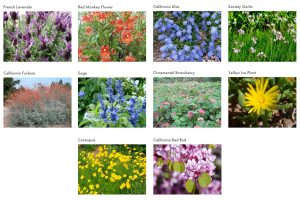As everyone is aware, California had its worst fire season on record in 2020. As residents of Calaveras, Tuolumne, and surrounding counties in the Sierra Foothills, we can never be too familiar with defensible space.
CAL Fire has a website: readyforwildfire.org, for detailed information on hardening your home, defensible space and fire-resistant landscape for more detailed information. For the purposes here, the assumption is that key hardscaping is already considered and in place.
Once fire-wise hardscaping is achieved, then plant selection should consider fire-resistant options in addition to the other needs of the specific plant chosen (USDA hardiness zone, water, light…).
Ground covers play an important role in landscaping. It could be that there is a need for some structure on a retaining wall, covering a recent construction area, or septic system, or just to tie in the aesthetic appeal of your landscape design. When choosing a ground cover, you would want to determine what is the goal you want to achieve? Some ground covers can be invasive.
When choosing a ground cover, additional items may want to be considered. Many California native plants are also drought-tolerant, and fire-resistant. This is ideal in the warmer, inland climate we experience in the Sierra Foothills during the summer and fall. One way to start is to look in your neighborhood or surrounding areas, if you see something you like, take a snapshot and identify the plant using one of the various plant identification apps on your smartphone. You could also reach out to your local UC Master Gardeners for insight.
The traits of fire-resistant plants include high moisture content or fleshy, succulent leaves; large or coarse leaves; lack of resinous, aromatic, oily, or waxy leaves or wood, and little or no loose or papery bark. Other traits include an extensive root system for erosion control, drought tolerance, and naturally low-growing form, open structure and ability to resprout after fire.
Below are just a few ground covers, and low-profile plants that are considered fire-resistant, but please keep in mind they need to be kept low, maintained and kept “non-woody”. Keep larger plants spaced apart to prevent the possibility of generating fuel during a fire. All these are components of landscape management practices, including irrigation, pruning and thinning and plant debris cleanup. This will have a greater impact on whether a plant is fire resistant than does the species or your plant selection. There is no such thing as a plant that will not burn, all plants will burn given enough heat and with conditions that favor combustion.
Creeping phlox: Easy to grow, attracts butterflies, deer resistant, ground cover, evergreen, good rock garden or alpine plant, multiplies/naturalizes.
Creeping thyme: Easy to grow, attracts butterflies, bee-friendly, deer resistant, rabbit resistant, fragrant flower/foliage, good ground cover, evergreen.
Ornamental strawberry: Regular water, attracts butterflies, PM shade in hottest climates. Grown for ornamental qualities.
Buckwheat: California buckwheat is easy to grow, hardy, prefers well-drained soil and sun. Flowers attract pollinators and low-growing varieties can be used as a ground cover.
Coral bells: A leafy plant with colorful foliage and drought resistant. A good ground cover at 12-18” tall and produces delicate flowers on tall, thin stalks.
California wild lilac: Evergreen, full sun, little or no water, attracts birds, butterflies, and bees. Blue flowers.
Rockrose: A compact shrub loves sun and heat, and is tolerant to both drought and poor soil conditions. Evergreen, attracts butterflies, flower color varies by species, many are variations of pink.
French lavender: Known for its attractive purple bloom, popular fragrance, and dried flowers. Although it contains scented oils, this plant is slow to ignite if kept moist. Attracts birds, bees, butterflies.
Please keep in mind, your specific elevation as that does play a role with the plants above. USDA hardiness zones are considered here, but only you have the knowledge on your specific location.
So, keep your property fire-resistant — happy gardening!
Ann Arshakuni is a University of California Cooperative Extension Master Gardener of Calaveras County.
UCCE Master Gardeners of Tuolumne and Calaveras Counties can answer home gardening questions. Call 209-533-5912 or fill out our easy-to-use problem questionnaire here. Check out our website here. You can also find us on Facebook.




